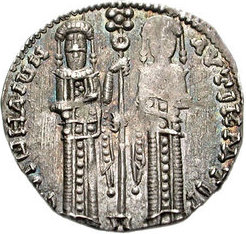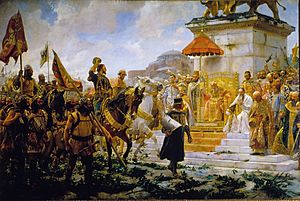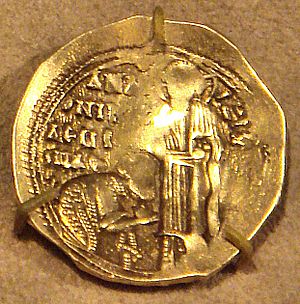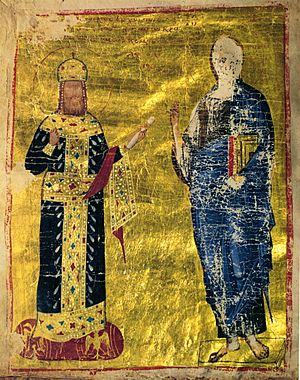Andronikos II Palaiologos facts for kids
Quick facts for kids Andronikos II Palaiologos |
|||||
|---|---|---|---|---|---|
| Emperor and Autocrat of the Romans | |||||
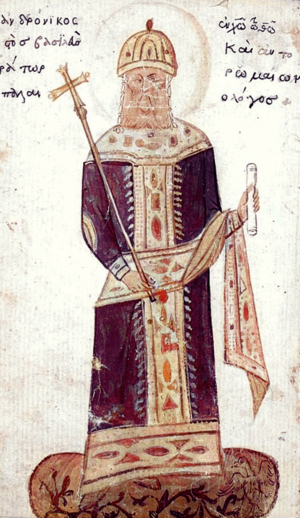
Miniature from the manuscript of George Pachymeres' Historia
|
|||||
| Byzantine emperor | |||||
| Reign | 11 December 1282 – 24 May 1328 |
||||
| Coronation | 8 November 1272 | ||||
| Predecessor | Michael VIII Palaiologos (alone) | ||||
| Successor | Andronikos III Palaiologos | ||||
| Co-emperor | Michael IX Palaiologos | ||||
| Proclamation | 1261 (as co-emperor) | ||||
| Born | 25 March 1259 Nicaea, Empire of Nicaea (now İznik, Bursa, Turkey) |
||||
| Died | 13 February 1332 (aged 72) Constantinople, Byzantine Empire (now Istanbul, Turkey) |
||||
| Spouse | Anna of Hungary Yolande of Montferrat |
||||
| Issue more... |
Michael IX Palaiologos Constantine Palaiologos John Palaiologos Theodore I, Marquis of Montferrat Demetrios Palaiologos Simonis (Simonida Nemanjić), Queen of Serbia Irene Palaiologina (wife of John II Doukas), Sebastokratorissa of Thessaly |
||||
|
|||||
| Dynasty | Palaiologos | ||||
| Father | Michael VIII Palaiologos | ||||
| Mother | Theodora Palaiologina | ||||
| Religion | Greek Orthodox | ||||
Andronikos II Palaiologos (Greek: Ἀνδρόνικος Δούκας Ἄγγελος Κομνηνὸς Παλαιολόγος, romanized: Andrónikos Doúkās Ángelos Komnēnós Palaiologos; 25 March 1259 – 13 February 1332), Latinized as Andronicus II Palaeologus, reigned as Byzantine emperor from 1282 to 1328. His reign marked the beginning of the recently-restored empire's final decline. The Turks conquered most of Byzantium's remaining Anatolian territories, and Andronikos spent the last years of his reign fighting his own grandson in the First Palaiologan Civil War. The war ended in Andronikos' forced abdication in 1328, after which he retired to a monastery for the remainder of his life.
Life
Andronikos was born on 25 March 1259, at Nicaea. He was the eldest surviving son of Michael VIII Palaiologos and Theodora Palaiologina, grandniece of John III Doukas Vatatzes.
Andronikos was acclaimed co-emperor in 1261, after his father Michael VIII recovered Constantinople from the Latin Empire, but he was not crowned until 8 November 1272. During their joint rule, he was compelled to support his father's unpopular Church union with the Papacy. Made sole emperor by Michael's death in 1282, Andronikos immediately repudiated the union, but was unable to resolve the related schism within the Orthodox clergy until 1310.
Andronikos II was also plagued by economic difficulties. During his reign the value of the Byzantine hyperpyron depreciated precipitously, while the state treasury accumulated less than one seventh the revenue (in nominal coins) that it had previously. Seeking to increase revenue and reduce expenses, Andronikos II raised taxes, reduced tax exemptions, and dismantled the Byzantine fleet (80 ships) in 1285, thereby making the Empire increasingly dependent on the rival republics of Venice and Genoa.
In 1291, he hired 50–60 Genoese ships, but the Byzantine weakness resulting from the lack of a navy became painfully apparent in the two wars with Venice in 1296–1302, and later again in 1306–10. In 1320, he tried to resurrect the navy by constructing 20 galleys, but failed.
Andronikos II Palaiologos sought to resolve some of the problems facing the Byzantine Empire through diplomacy. After the death of his first wife, Anne of Hungary, he married Yolanda (renamed Irene) of Montferrat, putting an end to the Montferrat claim to the Kingdom of Thessalonica.
Andronikos II also attempted to marry off his son and co-emperor Michael IX Palaiologos to the Latin Empress Catherine I of Courtenay, thus seeking to eliminate Western agitation for a restoration of the Latin Empire. Another marriage alliance attempted to resolve the potential conflict with Serbia in Macedonia, as Andronikos II married off his five-year-old daughter Simonis to King Stefan Milutin in 1298.
In spite of the resolution of problems in Europe, Andronikos II was faced with the collapse of the Byzantine frontier in Asia Minor, despite the successful, but short, governorships of Alexios Philanthropenos and John Tarchaneiotes. The military victories of Philanthropenos and Tarchaneiotes against the Turks were largely dependent on a considerable contingent of Cretan escapees, or exiles from Venetian-occupied Crete, headed by Hortatzis, whom Michael VIII had repatriated to Byzantium through a treaty agreement with the Venetians ratified in 1277. Andronikos II had resettled those Cretans in the region of Meander river, the southeastern Asia Minor frontier of Byzantium with the Turks.
After the failure of the co-emperor Michael IX to stem the Turkish advance in Asia Minor in 1302 and the disastrous Battle of Bapheus, the Byzantine government hired the Catalan Company of Almogavars (adventurers from Catalonia) led by Roger de Flor to clear Byzantine Asia Minor of the enemy. In spite of some successes, the Catalans were unable to secure lasting gains. Being more ruthless and savage than the enemy they intended to subdue, they quarreled with Michael IX and eventually turned on their Byzantine employers after the murder of Roger de Flor in 1305. Together with a party of willing Turks they devastated Thrace, Macedonia, and Thessaly on their road to Latin occupied southern Greece. There they conquered the Duchy of Athens and Thebes.
Meanwhile, the Anatolian beyliks continued to penetrate Byzantine territory. Prusa fell to the Ottoman Turks in 1326, and by the end of Andronikos II's reign much of Bithynia was in the hands of Osman I and his son and heir Orhan. Karasids conquered Mysia-region with Paleokastron after 1296, Germiyan conquered Simav in 1328, Saruhan captured Magnesia in 1313, and Aydinids captured Smyrna in 1310.
The Empire's problems were exploited by Theodore Svetoslav of Bulgaria, who defeated Michael IX and conquered much of northeastern Thrace in c. 1305–07. The conflict ended with yet another dynastic marriage, between Michael IX's daughter Theodora and the Bulgarian emperor. The dissolute behavior of Michael IX's son Andronikos III Palaiologos led to a rift in the family, and after Michael IX's death in 1320, Andronikos II disowned his grandson, prompting a civil war that raged, with interruptions, until 1328. The conflict precipitated Bulgarian involvement, and Michael Asen III of Bulgaria attempted to capture Andronikos II under the guise of sending him military support. In 1328 Andronikos III entered Constantinople in triumph and Andronikos II was forced to abdicate.
Andronikos II died as a monk at Constantinople in 1332, and was buried in the Lips Monastery (now the Fenari Isa Mosque).
Fiscal policy
The economic destitution which plagued the reign of Andronikos II caused him to undertake drastic measures to cut state spending. These cuts included the native army, which was reduced to a near-token force and largely superseded, first by foreign mercenary companies and then by militias. As shown by the failed campaign of Andronikos's co-emperor Michael XI, these inexperienced militiamen made countering the Turkish advance a difficult and dangerous undertaking.
For a time the Byzantine navy was completely disbanded, leaving the empire reliant on Genoese and Venetian forces who charged exorbitantly for their service. Many discharged Byzantine sailors and shipbuilders found employment with the Turkomans, who had just reached the western Anatolian coast and sought to build up their own naval forces. The resulting new fleets contributed greatly to the exploding problem of Turkic piracy in the Aegean Sea, ravaging trade routes and coastal lands alike.
In 1320, as a result of heightened taxation and more rigorous policies of collection, Andronikos II was able to raise a total of 1 million Hyperpyra for the budgetary year of 1321. He intended to use the money to expand his army to some 3000 horsemen, and to recreate the Byzantine Navy by building 20 ships. This plan, militarily ambitious though still insufficient for the needs of the empire, was disrupted by Andronikos II's impending civil war with his grandson Andronikos III.
For the sake of comparison, it has to be noted that the Hyperpyron from 1320 was worth half as much as the undebased Nomisma from the reign of Basil II.
| Budgetary Item | Estimated total
(millions of hyperpyra) |
|---|---|
| Bodyguards
500 x 144hyp x 4/3 |
0.096M hyp. |
| Soldiers
3000 x 144hyp x 4/3 |
0.288M hyp. |
| Oarsmen
20ships x 5000hyp x 4/3 |
0.1M hyp. |
| Army supplies
3500 x 20hyp |
0.07M hyp. |
| Navy supplies
3080 x 10hyp |
0.031M hyp. |
| fodder & horses
3500 x 10hyp |
0.035M hyp. |
| Catalan Campaign | 0.05M hyp. |
| Civil Expenses | 0.33M hyp. |
| Total | 1.0M hyp. |
Early Church policy
As Andronikos broke the church union of his father he also removed many of his church appointments, including the pro-unionist Patriarch John XI. The new, anti-unionist Patriarch Joseph I resigned his office and died the following year, and was replaced by a Cypriot who took the name Gregory II.
Andronikos also faced the Arsenite Schism, a movement which was anti-union but otherwise had little common ground with the emperor. Its name was derived from the former Patriarch Arsenios, who was removed from office after excommunicating Michael VIII for having blinded and imprisoned John IV. The Arsenites held that the captive John was the rightful Byzantine Emperor and that the Patriarchs John XI, Joseph I, and now Gregory II were illegitimate.
To try and mend this schism, Gregory called for a church synod to which he invited both the Patriarchs of Alexandria and Antioch, asking them to rescind their previous pro-unionist declaration. The Patriarch of Antioch refused, then abdicated from his office and fled to Syria. Gregory also extracted a public avowal from the Empress Theodora, that she would never ask that her deceased husband Michael VIII receive a Christian burial. Though this Synod did much to satisfy the Orthodox Clergy, it failed to do the same with the Arsenites.
A few years later Gregory II was forced to resign, as some of his writings were deemed to be heretical. His replacement, chosen by Andronikos in order to distract from an ever-worsening political situation, was an Athonite hermit who took the name Athanasius. The new Patriarch was intensely ascetic, and spent much of his time repudiating clergymen for their earthly possessions; eventually he sought to confiscate property from some of the wealthier churches and monasteries. Many clergymen responded with overt hostility, going as far as pelting him with stones as he walked the streets of Constantinople. Athanasius ceased to appear in public without a bodyguard.
When in the summer of 1293 Andronikos returned from a visit to his swiftly-dwindling Anatolian holdings, he was met by a delegation of leading clergyman who demanded the deposition of Athanasius. Andronikos was unwilling, but the strength of the opposition eventually forced him to comply. Meanwhile, Athanasius personally penned a church bull in which he excommunicated the clergymen who had denounced him, hiding it in a pillar in the northern gallery of Hagia Sophia. It was only found a few years later, causing much uproar.
Family
On 8 November 1272 Andronikos II married as his first wife Anna of Hungary, daughter of Stephen V of Hungary and Elizabeth the Cuman, with whom he had two sons:
- Michael IX Palaiologos (17 April 1277 – 12 October 1320).
- Constantine Palaiologos, despotes (c. 1278 – 1335). Constantine was forced to become a monk by his nephew Andronikos III Palaiologos.
Anna died in 1281, and in 1284 Andronikos married Yolanda (renamed Irene), a daughter of William VII of Montferrat, with whom he had:
- John Palaiologos (c. 1286–1308), despotes.
- Bartholomaios Palaiologos (born 1289), died young.
- Theodore I, Marquis of Montferrat (1291–1338).
- Simonis Palaiologina (1294 – after 1336), who married King Stefan Milutin of Serbia.
- Theodora Palaiologina (born 1295), died young.
- Demetrios Palaiologos (1297–1343), despotēs.
- Isaakios Palaiologos (born 1299), died young.
Andronikos II also had at least three illegitimate daughters:
- Irene, who first married Ghazan, Khan of Persia, and laterJohn II Doukas, ruler of Thessaly.
- Maria, who married Toqta, Khan of the Golden Horde.
- A daughter known as Despina Khatun, who married Öljaitü, Khan of the Ilkhanate.
Foundations
- Ardenica Monastery
- Panagia Olympiotissa Monastery
- Zograf monastery
See also
 In Spanish: Andrónico II Paleólogo para niños
In Spanish: Andrónico II Paleólogo para niños


